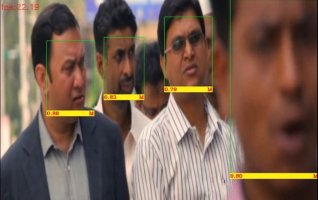
With face recognition technology becoming increasingly accessible, thanks to great strides made recently in machine learning and AI, the time is ripe to start developing solutions around this to quickly capitalise on this emerging market. Face analytics has become inevitable in many applications - from Social media to Security systems. Many estimates indicate a steady annual growth of 13% for net market worth of face recognition technologies which will reach at least 7.7 Billion USD by 2022 [ref].
If you have entered this market and are planning to develop a custom solution for your client, you might find reading our article comparing various existing face recognition SDKs and APIs beneficial. These can be integrated into your application and do the heavy lifting.
This article demonstrates using Deepsight SDK for the purpose of real time face detection and demographic analysis on surveillance videos. The video below demonstrates our objective. Deepsight installation is easy and only takes a couple of minutes.
tutorial.py
[python]
import cv2
import requests
import numpy as np
import json
import argparse
import signal
import logging
import datetime, time
import os
face_api = "http://localhost:5000/inferImage?returnFaceAttributes=true"
compare_api = "http://localhost:5000/compareFaces"
# parse arguments
parser = argparse.ArgumentParser(description='Realtime Face Analytics')
parser.add_argument('--src', action='store', default=0, nargs='?', help='Set video source; default is usb webcam')
parser.add_argument('--w', action='store', default=320, nargs='?', help='Set video width')
parser.add_argument('--h', action='store', default=240, nargs='?', help='Set video height')
args = parser.parse_args()
inp_w = int(args.w)
inp_h = int(args.h)
# start the camera
cap = cv2.VideoCapture(args.src)
cap.set(cv2.CAP_PROP_FRAME_WIDTH, float(args.w))
cap.set(cv2.CAP_PROP_FRAME_HEIGHT, float(args.h))
ret, frame = cap.read()
# To record video uncomment these lines
#fourcc = cv2.VideoWriter_fourcc(*'XVID') # Define the codec and create VideoWriter object
#out = cv2.VideoWriter(os.path.basename(args.src)[:-4]+"_out.avi",fourcc, 25.0, (inp_w,inp_h))
# catch exit signal
def signal_handler(signal, frame):
global cap
#out.release()
cap.release()
print("Exit")
exit(0)
signal.signal(signal.SIGINT, signal_handler)
male_icon = cv2.imread("m.png", -1)
female_icon = cv2.imread("f.png", -1)
# start processing
count = 0
while True:
_, framex = cap.read()
key = cv2.waitKey(1) & 0xFF
count +=1
# if count%3!=0:
# continue
frame = cv2.resize(framex, (int(args.w),int(args.h)))
r, imgbuf = cv2.imencode(".bmp", frame)
image = {'pic':bytearray(imgbuf)}
start_time = time.time()
r = requests.post(face_api, files=image, timeout=10)
result = r.json()
t = time.time() - start_time
print("---%0.3fs %0.3fFPS ---" %(t, 1/t))
if len(result) > 1:
faces = result[:-1]
diag = result[-1]['diagnostics']
for face in faces:
#rect = [face[i] for i in ['faceRectangle']][0]
rect, gender, age = [face[i] for i in ['faceRectangle', 'gender', 'age']]
x,y,w,h, confidence = [rect[i] for i in ['left', 'top', 'width', 'height', 'confidence']]
if confidence < 0.4:
continue
cv2.rectangle(frame,(x,y),(x+w,y+h),(0,255,0),1,8)
cv2.rectangle(frame, (x,y-10), (x+w,y), (0,255,255), -1, 8)
cv2.rectangle(frame, (x,y+h-10), (x+w,y+h), (0,255,255), -1, 8)
cv2.putText(frame,"%s"%(age), (x,y-2), cv2.FONT_HERSHEY_COMPLEX_SMALL, 0.5, (0,0,255),1)
cv2.putText(frame, "%0.2f" % (confidence), (x, y+h-2), cv2.FONT_HERSHEY_COMPLEX_SMALL, 0.5, (0, 0, 255),1)
cv2.putText(frame, "%s"%(gender[0]), (x+w-10,y+h-2), cv2.FONT_HERSHEY_COMPLEX_SMALL, 0.5, (0,0,255),1)
cv2.putText(frame, "fps:%0.2f"%(1000/float(diag['elapsedTime'].split(" ")[0])), (0,20), cv2.FONT_HERSHEY_SIMPLEX, 0.5, (0,0,255))
# uncomment below to record to disk
#out.write(frame)
cv2.imshow("frame", frame)
if key == ord('q'):
break
[/python]
pip3 install requestspython3 app.py --src /path/to/vidYou can explore other arg params using the --help switch.
This tutorial demonstrates how Deepsight SDK makes developing face analytics applications extremely easy. It is possible to modify the tutorial code to improve upon the features.
Feel free to comment below for any queries.